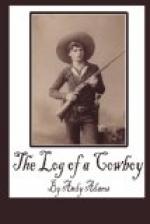The horses, however, gave us a long, hard run, and since a horse has a splendid memory, the effects of this scare were noticeable for nearly a month after. Honeyman at once urged our foreman to hobble at night, but Flood knew the importance of keeping the remuda strong, and refused. But his decision was forced, for just as it was growing dusk that evening, we heard the horses running, and all hands had to turn out, to surround them and bring them into camp. We hobbled every horse and side-lined certain leaders, and for fully a week following, one scare or another seemed to hold our saddle stock in constant terror. During this week we turned out our night horses, and taking the worst of the leaders in their stead, tied them solidly to the wagon wheels all night, not being willing to trust to picket ropes. They would even run from a mounted man during the twilight of evening or early dawn, or from any object not distinguishable in uncertain light; but the wrangler now never went near them until after sunrise, and their nervousness gradually subsided. Trouble never comes singly, however, and when we struck the Salt Fork, we found it raging, and impassable nearly from bank to bank. But get across we must. The swimming of it was nothing, but it was necessary to get our wagon over, and there came the rub. We swam the cattle in twenty minutes’ time, but it took us a full half day to get the wagon over. The river was at least a hundred yards wide, three quarters of which was swimming to a horse. But we hunted up and down the river until we found an eddy, where the banks had a gradual approach to deep water, and started to raft the wagon over—a thing none of the outfit had ever seen done, though we had often heard of it around camp-fires in Texas. The first thing was to get the necessary timber to make the raft. We scouted along the Salt Fork for a mile either way before we found sufficient dry, dead cottonwood to form our raft. Then we set about cutting it, but we had only one axe, and were the poorest set of axemen that were ever called upon to perform a similar task; when we cut a tree it looked as though a beaver had gnawed it down. On horseback the Texan shines at the head of his class, but in any occupation which must be performed on foot he is never a competitor. There was scarcely a man in our outfit who could not swing a rope and tie down a steer in a given space of time, but when it came to swinging an axe to cut logs for the raft, our lustre faded. “Cutting these logs,” said Joe Stallings, as he mopped the sweat from his brow, “reminds me of what the Tennessee girl who married a Texan wrote home to her sister. ‘Texas,’ so she wrote, ’is a good place for men and dogs, but it’s hell on women and oxen.’”




